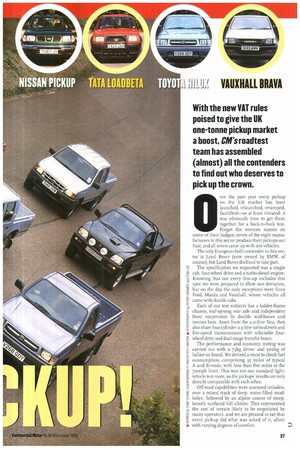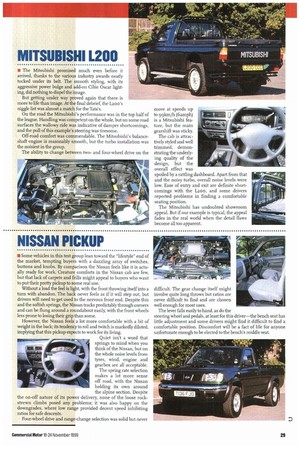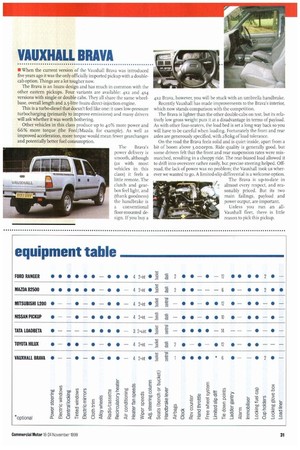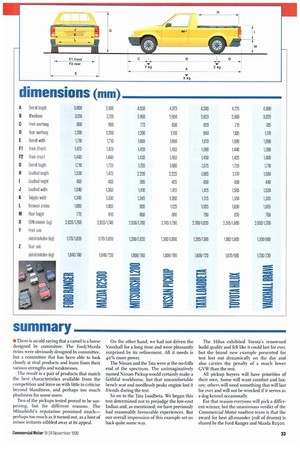CROUPIER
Page 28

Page 29

Page 30

Page 31

Page 32

Page 33

Page 35

If you've noticed an error in this article please click here to report it so we can fix it.
With the new VAT rules poised to give the UK one-tonne pickup market a boost, Chi's roadtest team has assembled (almost) all the contenders to find out who deserves to pick up the crown.
0 ver the past year every pickup on the UK market has been launched, relaunched, revamped, facelifted—or at least titivated: it was obviously time to get them together for a back-to-back test. Forget the western names on some of their badges; seven of the eight manufacturers in this sector produce their pickups out East, and all seven came up with test vehicles.
The only European-built contender in this sector is Land Rover (now owned by BMW, of course), but Land Rover declined to take part.
The specification we requested was a single cab, four-wheel drive and a turbo-diesel engine. Knowing that not every line-up includes this spec we were prepared to allow one deviation, but on the day the only exceptions were from Ford, Mazda and Vauxhall, whose vehicles all came with double cabs.
Each of our test subjects has a ladder-frame chassis, leaf-sprung rear axle and independent front suspension by double wishbones and torsion bars. Apart from the 2.0-litre Tata, they also share four-cylinder 2.5-litre turbo-diesels and five-speed transmissions with selectable fourwheel drive and dual-range transfer boxes.
The performance and economy testing was carried out with a 75kg driver and 50 okg of ballast on board. We devised a route to check fuel consumption, comprising 35 miles of typical A and B-roads, with less than five miles at the 70m ph limit. This was not our standard lightvehicle test route, so the pickups' results are only directly comparable with each other.
Off-road capabilities were assessed unladen, over a mixed track of deep, water-filled mud. holes, followed by an alpine course of steep, loosely surfaced hill climbs. This represented the sort of terrain likely to be negotiated by many operators, and we are pleased to say that every pickup did what was asked of it, albeit
with varying degrees of comfort. ...,
FORD RANGER
• Ford has always had a genius for marketing, and the Ranger shows the impact this can have on a vehicle. The product planners have taken a good, hard look at the competition, noted the best points of each, and told the engineers to do their darndest to match them.
On paper the specifications and measured performance of the Ranger are hardly exceptional, but the overall impression is that this pickup is more refined and more thoroughly developed than most of its competitors.
Of course, the Mazda B-Series is substantially the same vehicle and Mazda engineers must take the credit for the Thai-built Ranger.
The Ranger range is limited to two 02 versions (Regular and Super Cab), a 04 with the Super Cab (which is a stretched two-door cab) and the 4x4 Double Cab tested here.
Only the Double Cab features this io7hp turbo-diesel. The other variants make do with a naturally aspirated 76hp unit which is no sluggard (we currently have a Super Cab on long-term test) but the extra urge of the turbo-diesel is certainly welcome. Only the Mazda could keep up with it in our standing-start acceleration test, and the Ranger had enough torque to feel quite relaxed on the road route with the bonus of decent fuel economy.
The turbo-diesel is quiet, too—only the Mazda was quieter at speed—and its trim is better than average (though the hard grey plastic betrays its oriental origins). The spacious, well-equipped cab underlines how far this class of vehicle has come in only a few years. There is no doubt that the Ranger has been optimised for on-road comfort, but this doesn't seem to have compromised its handling too much. The main thing to watch out for is load distribution. While there is plenty of tolerance in the axles, most of the load bed is outside the wheelbase so it is all too easy to make the Ford tail-heavy and nose-light.
Off-road, the Ranger is on a par with the rest of the pack. Engine braking is good (helped by the deep 2.211 gearing of the transfer box), though the relatively long wheelbase does not help ground clearance and it would be a positive step to have the option of a limited-slip (or lockable) cliff.
In all, the Ranger is an excellent blend of productivity, build quality and comfort, which deserves a place on anybody's shortlist. But nobody's perfect—after all, it still has an umbrella handbrake.
MAZDA B2500
• For a working vehicle the Mazda offers a particularly smooth ride. Wind, tyre and engine noise are loud enough to remind the driver that he is on the road rather than floating above it, but quiet enough to make long journeys an absolute breeze. Comfort is also enhanced by features such as carpets, electric windows, an upmarket stereo and a rake-adjustable steering wheel.
The gear change has a solid feel, easy selection and short throw, with ratios that feel equally suitable around town, down twisty lanes or cruising along the motorway.
The suspension carries the Mazda along with aplomb, taking corners with little lean and certainly no drama. A drive through the woods is like a walk in the park; the four-wheel-drive grip might not be staggering but Mazda is probably right in assuming that most buyers will want quieter tyres which are more at home on the road than the field. If you are heading into the rough you can always fit some mud pluggers.
You would be hard pushed to tell the Mazda from its Ranger doppelganger. It would be easy to whinge about common platform design throwing up indistinguishable models which are boring, bland and as uniform as the food provided by a well-known hamburger chain. But who wants unique models that deafen you with wind noise? Or individual design that leaves you standing on the hard shoulder, curs ing your buy as oil begins to seep through the soles of your moccasins? When a common platform design is as smooth and quiet as this Mazda, we will thankfully take a test-tubebred quarter-pound of cloned flesh any day of the week.
MITSUBISHI L200
• The Mitsubishi promised much even before it arrived, thanks to the various industry awards neatly tucked under its belt. The smooth styling, with its aggressive power bulge and add-on Cibie Oscar lighting, did nothing to dispel the image.
But getting under way proved again that there is more to life than image. At the final debrief, the Lzoo's niggle list was almost a match for the Tata's.
On the road the Mitsubishi's performance was in the top half of the league. Handling was competent on the whole, but on some road surfaces the wallowy ride was indicative of damper shortcomings, and the pull of this example's steering was tiresome.
Off-road comfort was commendable. The Mitsubishi's balanceshaft engine is reasonably smooth, but the turbo installation was the noisiest in the group.
The ability to change between twoand four-wheel drive on the move at speeds up to 9 91cm/h (62mph) is a Mitsubishi feature, but the main gearshift was sticky.
The cab is attractively styled and well trimmed, demonstrating the underlying quality of the design, but the overall effect was spoiled by a rattling dashboard. Apart from that and the noisy turbo, overall noise levels were low. Ease of entry and exit are definite shortcomings with the L200, and some drivers reported problems in finding a comfortable seating position.
The Mitsubishi has undoubted showroom appeal. But if our example is typical, the appeal fades in the real world when the detail flaws become all too apparent.
NISSAN PICKUP
[Some vehicles in this test group lean toward the "lifestyle" end of the market, tempting buyers with a dazzling array of switches,
buttons and knobs. By comparison the Nissan feels like it is actually ready for work. Creature comforts in the Nissan cab are few, but that lack of carpets and frills might appeal to buyers who want to put their pretty pickup to some real use.
Viithout a load the feel is light, with the front throwing itself into a tum with abandon. The back never feels as if it will step out, but drivers will need to get used to the nervous front end. Despite this and the sollish springs, the Nissan tracks predictably through corners and can be flung around a roundabout easily, with the front wheels less prone to losing their grip than some, However, the Nissan feels a lot more comfortable with a bit of weight in the back; its tendency to roll and twitch is markedly diluted, implying that this pickup expects to work for its living.
Quiet isn't a word that springs to mind when you think of the Nissan, but on the whole noise levels from tyres, wind, engine and gearbox are all acceptable.
The spring rate selection makes a lot more sense off road, with the Nissan
holding its own around the alpine section. Despite
the on-off nature of its power delivery, none of the loose rock strewn climbs posed any problems; it was also happy on the downgrades, where low range provided decent speed inhibiting ratios for safe descents.
Four-wheel drive and range-change selection was solid but never difficult. The gear change itself might involve quite long throws but ratios are never difficult to find and are chosen well enough for most uses.
The lever falls easily to hand, as do the steering wheel and pedals, at least for this driver—the bench seat has little adjustment and some drivers might find it difficult to find a comfortable position. Discomfort will be a fact of life for anyone unfortunate enough to be elected to the bench's middle seat.
TATA LOADBETA
• The Tata initially presented us with something of a conundrum. It arrived with 173 miles on the clock, but looked and felt much older— we subsequently discovered it had done more than 12,000 demonstration miles. It had obviously had a harder life than any of its shiny competitors, so our comments should be read with this in mind.
When CM last tested a Tata we were impressed by an overall quality which belied its bargain-basement price; our only real reservation being the under-developed interior.
Things were rather different this time. We were prepared to make allowances for the half-litre of engine displacement given away to the rest of the pack (in fact, it still produces more power than the Toyota or the Vauxhall) but we were not prepared for the general feeling of tiredness in a T-reg vehicle. Everything in the cab made a noise, whether it was the seat springs squeaking, doors rattling or dashboard creaking. Although the finer points of trim, fit and finish were lacking, the actual build strength of the Tata was to up to main battle tank standards. Unfortunately, the paint was less confidence inspiring, with patches of bare metal already showing in the loadbed. The gear change was noted by all drivers as being sloppy, with concentration needed to avoid confusing the adjacent first and reverse slots. The brakes worked well, eventually, but were initially uninspiring, needing heavy pedal pressures to get things happening. Dynamically, the only area where the Tata impressed was off-road—the way it stormed up the steeper hills on our test course laughed off its relative lack of cubic centimetres. That off-road ability was rather compromised by a restricted steering lock, despite having the shortest wheelbase of the group (which came into its own on the knife-edge traverse).
On the evidence of this test we suspect that the Tata is likely to show a certain degree of ageing quite quickly, before settling down to work hard long after its invoice is forgotten.
TOYOTA HILUX
• The Hilux turned up at the proving ground with just 42 miles on the clock, and therein may have lain some of its problems.
Performance was a little down on our expectations, and was not helped by having the second lowest power output of the group. But the mediocre fuel economy that we encountered pointed to a tight engine. We know from previous experience that it is capable of doing considerably better than this.
The braking performance was also disappointing. It was the worst of the group by a long way, the poor peak figures indicating a lack of bedding-in. Some drivers felt that the steering was too light in the straight-ahead position, while the recently softened suspension is still at the firm end of the spectrum, with a tendency to skittishness at the rear on poor surfaces.
Although the engine is probably not the smoothest of the bunch, effective mounting does a good job of hiding the fact. The 44 Single Cab is arguably the best looking of the Hilux range, with some subtle graphics and attractively styled steel wheels, but without the excessive chrome of the Double Cab.
This cab was well liked, with its tall design giving good headroom. Sitting at the wheel you would he hard pushed to identify which Toyota you were in, with no compromises for a working vehicle.
Fit and finish in every area were exemplary, 11'1(1 equipment levels were reasonable, although this was the only vehicle in the group without a rev counter.
Toyota's reputation for reliability is enhanced by features such as the twin battery installation. Overall, this example gave the impression of needing time to settle down before going on to give a lifetime of faithful service.
VAUXHALL BRAVA
• When the current version of the Vauxhall Brava was introduced five years ago it was the only officially imported pickup with a doublecab option. Things are a lot tougher now.
The Brava is an Isuzu design and has much in common with the other eastern pickups. Four variants are available: 4x2 and 4x4 versions with single or double cabs. They all share the same wheelbase, overall length and 2.5-litre I suzu direct-injection engine.
This is a turbo-diesel that doesn't feel like one: it uses low-pressure turbocharging (primarily to improve emissions) and many drivers will ask whether it was worth bothering.
Other vehicles in this class produce up to 40% more power and 66% more torque (the Ford/Mazda, for example). As well as improved acceleration, more torque would mean fewer gearchanges and potentially better fuel consumption.
The Brava's power delivery is smooth, although (as with most vehicles in this class) it feels a little remote. The clutch and gearbox feel light, and (thank goodness) the handbrake is a conventional floor-mounted design. If you buy a 4x2 Brava, however, you will be stuck with an umbrella handbrake. Recently Vauxhall has made improvements to the Brava's interior. which now stands comparison with the competition.
The Brava is lighter than the other double-cabs on test, but its relatively low gross weight puts it at a disadvantage in terms of payload. As with other four-seaters, the load bed is set a long way back so you will have to be careful when loading. Fortunately the front and rear axles are generously specified, with 280kg of load tolerance.
On the road the Brava feels solid and is quiet inside, apart from a bit of boom above 3,000rpm. Ride quality is generally good, but some drivers felt that the front and rear suspension rates were mismatched, resulting in a choppy ride. The rear-biased load allowed it to drift into oversteer rather easily, but precise steering helped. Offroad, the lack of power was no problem; the Vauxhall took us wherever we wanted to go. A limited-slip differential is a welcome option.
The Brava is up-to-date in almost every respect, and reasonably priced. But its two main failings, payload and power output, are important.
Unless you run an allVauxhall fleet, there is little reason to pick this pickup.
summary II There is an old saying that a camel is a horse designed by committee. The Ford/Mazda twins were obviously designed by committee, but a committee that has been able to look closely at rival products and learn from their various strengths and weaknesses.
The result is a pair of products that match the best characteristics available from the competition and leave us with little to criticise beyond blandness, and perhaps too much plushness for some users.
Two of the pickups tested proved to be surprising, but for different reasons. The Mitsubishi's reputation promised muchperhaps too much as it turned out, as a host of minor irritants nibbled away at its appeal. On the other hand, we had not driven the Vauxhall for a long time and were pleasantly surprised by its refinement. All it needs is 40% more power.
The Nissan and the Tata were at the no-frills end of the spectrum. The unimaginatively named Nissan Pickup would certainly make a faithful workhorse, but that uncomfortable bench seat and needlessly peaky engine lost it friends during the test.
So on to the Tata Loadbeta. We began this test determined not to prejudge the low-cost Indian and, as mentioned, we have previously had reasonably favourable experiences. But our overall impression of this example set us back quite some way.
The Hilux exhibited Toyota's renowned build quality and felt like it could last for ever, but the brand new example presented for test lost out dynamically on the day and also carries the penalty of a much lower GVW than the rest.
All pickup buyers will have priorities of their own. Some will want comfort and luxury; others will need something that will last for ever and will not be wrecked if it serves as a dog kennel occasionally.
For that reason everyone will pick a different winner, but the unanimous verdict of the Commercial Motor roadtest team is that the award for best all-rounder (roll of drums) is shared by the Ford Ranger and Mazda B2500.
















































































































